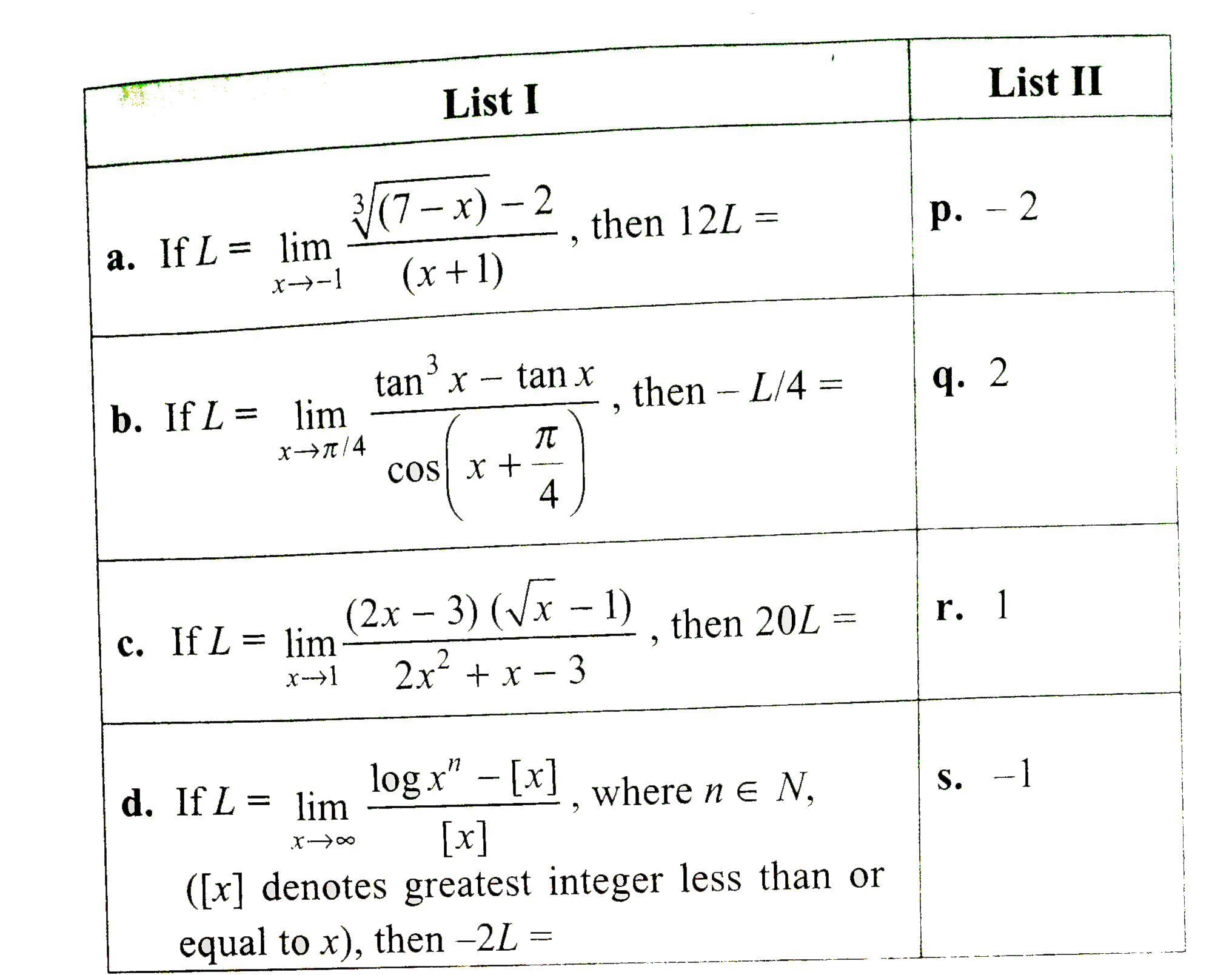If L=limx→∞(x+1−√ax2+x+3) exists finitely then
The value of L isSolution in Tamil
The correct Answer is:B
L=limx→∞(x+1−√ax2+x+3)
=limx→∞((x+1)2−(ax2+x+3)x+1+√ax2+x+3)
=limx→∞((1−a)x2+x−2x+1+√ax2+x+3)
L exists finitely if 1−a=0 or a=1
∴ L=limx→∞(x−2x+1+√x2+x+3)
=limx→∞⎛⎜
⎜⎝1−2x1+1x+√1+1x+3x2⎞⎟
⎟⎠
Topper's Solved these Questions
- BOOK - CENGAGECHAPTER - LIMITSEXERCISE - Exercise (Matrix)5videos
LIMITS
- BOOK - CENGAGECHAPTER - LIMITSEXERCISE - Exercise (Numerical)23videos
LIMITS
- BOOK - CENGAGECHAPTER - LIMITSEXERCISE - Exercise (Multiple)18videos
LIMITS
- BOOK - CENGAGECHAPTER - JEE 2019EXERCISE - Chapter 109videos
JEE 2019
- BOOK - CENGAGECHAPTER - LINEAR COMBINATION OF VECTORS, DEPENDENT AND INDEPENDENT VECTORSEXERCISE - DPP 1.210videos
LINEAR COMBINATION OF VECTORS, DEPENDENT AND INDEPENDENT VECTORS
Similar Questions
Match the following lists:
 07:09View Solution
07:09View SolutionThe reciprocal of the value of: (lim)n→∞(1−122)(1−132)(1−142)(1−1n2)is
13:53View SolutionLet f(x)={1+2xa,0≤x<1ax,1≤x<2.If(lim)x→1f(x)eξsts,thenais 1 (b) −1 (c) 2 (d) −2
03:40View SolutionIf y = y(x) is the solution of the differential equation, xdydx+2y=x2 satisfying y(1) = 1, then y(12) is equal to
04:31View SolutionThe number of integral values of p for which (p+1)ˆi−3ˆj+pˆk,pˆi+(p+1)ˆj−3ˆk and −3ˆi+pˆj+(p+1)ˆk are linearly dependent vectors is q
04:31View SolutionIf the lim_(x rarr0)(1)/(x^(3))((1)/(sqrt(1+x))-(1+ax)/(1+bx)) exists and has the value equal to l, then find the value of (1)/(a)-(2)/(l)+(3)/(b)
05:22View SolutionIf lim_(x rarr oo)x^(a)(sqrt(x^(2)+sqrt(x^(4)+1))-sqrt(2x)) exists and has value non-zero finite real aumber L, then find the value of (alpha)/(L^(2))
03:22View Solutionlim_(x->oo) {sqrt(x^4-x^2+1)-ax^2-a}=A finite value. Then a is equal to-
03:37View SolutionIf L=limx→∞(x+1−√ax2+x+3) exists infinetely then
The value of a is04:52View SolutionIf L=limx→∞(x+1−√ax2+x+3) exists finitely then
The value of L is03:11View SolutionIf limx→0sin2x−asinx(x3)3=L exists finitely, then the absolute value of L is equal to
06:15View SolutionIf limx→∞f(x) exists and is finite and nonzero and if limx→∞{f(x)+3f(x)−1f2(x)}=3,then the value of limx→∞f(x) is
05:30View SolutionIf L=limx→01x3(1√1+x−1+ax1+bx) exists,then
06:01View SolutionIf L=limx→0sinx+aex+be−x+cloge(1+x)x3 exists finitely, then
The value of L is03:54View SolutionIf L=limx→∞(x+1−√ax2+x+3) exists infinetely then
The value of a is02:27View Solution

